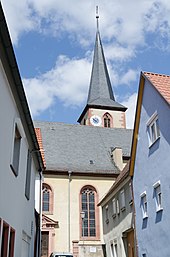St. Andreas (Erlabrunn)
The Roman Catholic parish church of St. Andreas is a post-Gothic hall church in Erlabrunn in the Lower Franconian district of Würzburg . It belongs to the parish of St. Andreas Erlabrunn in the deanery of Würzburg left of the Main in the diocese of Würzburg .
history
The exact age of the church is not recorded. The Erlabrunn church is one of the churches in the district of Würzburg , along with St. Andreas (Ochsenfurt) , with an Andreas patronage , which suggests that it was founded at the time of Bishop Burkard . A church building is mentioned for the first time in 1372. In 1554 the church patronage of the parish Hettstadt with the Erlabrunn branch was transferred to the Oberzell monastery . The pleban Wolfgang Herbst held office here from 1573 to 1591 . On February 22, 1591, the Erlabrunn branch church was raised to a parish by the Bishop of Würzburg, and Balthasar Stoltz became the first pastor. The place Margetshöchheim belonged as a branch of this new parish . In 1655 the old church was closed and a new church was built, which was consecrated on September 16, 1657. The consecration was carried out by the auxiliary bishop from Würzburg Johann Melchior Söllner. Margetshöchheim was transferred to the parish Mittelzell as a branch in 1673 and became its own parish in 1754.
architecture
The building is a uniform post-Gothic structure with a tower from 1655 with a real peak . The choir, closed on three sides, is vaulted with attached stucco ribs, the nave is closed off by a stuccoed flat ceiling showing the heads of angels in coffers. The north portal is provided with an inscription in which Franz Thomas Meisner is named as the founder of the church furnishings in the 18th century. The main portal of the church in the west is provided with rustic walls and a segmented gable , in the gable of which an inscription commemorates the laying of the foundation stone on June 17, 1655. The south portal has a richly decorated garment and a triangular gable with the coat of arms of the then ruling Prince-Bishop Johann Philipp von Schönborn . A new sacristy made of in- situ concrete was added to the south side in 1965/66 . After entering the church one stands below the organ loft built far into the room, which restricts the view of the choir arch and choir to about a third.
Furnishing
The tombstone of Barbara Meisner, who died in 1700, can be found on the northern outer wall. There are also two figures of St. Roch and St. Sebastian from the 18th century. On the southern outer wall there is a figure of Saint Joseph, the nursing father of Jesus, and the modern figure of Saint Anthony of Padua . The 14 Stations of the Cross, created by Josef Fleck from Fulda in 1947, can be found on both side walls .
The modern Marian altar with a Madonna from around 1700 is arranged on the eastern left end wall of the nave. On the eastern right end wall there is a fourteen saints altar with sculptures from 1658. These figures were commissioned by Pastor Eckardi. The font is made of red sandstone. In the choir arch with the year 1655 is the triumphal cross. On its outer walls, the choir contains the sacrament house from the Gothic church from around 1500. Above it is a representation of the risen Christ, which was originally attached to the sound cover of the pulpit. A painting of the Lamentation of Christ from the workshop of Oswald Onghers is arranged above the approach to the tower . At the location of the former high altar is a gray stone stele with the tabernacle and a band of figures depicting Christ and the four evangelists, with the figure of St. Andrew in the middle. All of these figures were attached to the baroque pulpit. The altar table as well as the ambo have a modern design. The windows illuminating the choir with contemporary stained glass come from the painter Curd Lessig from Würzburg and were created in 1966/1967. On the ceiling that closes the nave , the monograms of Mary, Andrew and Christ are affixed in the middle , the interlocking cassette fields show 57 winged angel heads from 1656, which belong to the Renaissance style. Three bells (St. Andrew's bell, chime g sharp, Ave Maria bell, chime h and the Marienglocke, chime c sharp) form the ring.
organ
The original organ by Johann Philipp Seuffert from 1761 was traded in for the organ installed in 1967. This baroque organ has stood in the Münster of Überlingen as the Marien organ since 1975 . Today's organ is a work by Norbert Krieger from 1968.
Surroundings
The walled cemetery was formerly built around the church. As the center of the cemetery, the cemetery cross is placed to the north, with an inscription which the donor couple Andreas and Katharina Busch names. In the northern part of the former cemetery is the new sacristy and a free-standing statue of the Lourdes Madonna.
literature
- Georg Dehio : Handbook of the German art monuments. Bavaria I. The administrative districts of Upper Franconia, Middle Franconia and Lower Franconia. Deutscher Kunstverlag, Munich / Berlin 1999, ISBN 3-422-03051-4 , p. 326.
Web links
- Website with information about the parish on the website of the Erlabrunn community
- Kathpedia article
Individual evidence
- ↑ Information about the organ on orgbase.nl. Retrieved March 25, 2020 .
Coordinates: 49 ° 51 '36.2 " N , 9 ° 50' 36" E



